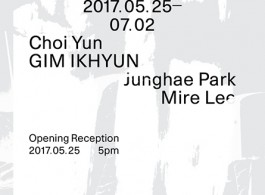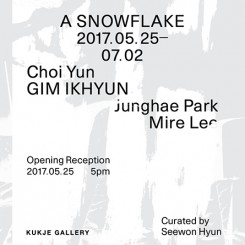CHOI YUN, GIM IKHYUN, JUNGHAE PARK & MIRE LEE
Kukje Gallery
Kukje Gallery is pleased to present A Snowflake, a group show of young contemporary Korean artists organized by guest curator Seewon Hyun, Co-Director of Audio Visual Pavilion. Each of the four artists participating in A Snowflake interprets the visible world in a different way. Hyun’s curatorial framework explores “how young contemporary artists see the world in 2017,” capturing their views on “what shape it is in.” The artist Junghae Park simultaneously sees deserts, tears, friends, and trees. Choi Yun’s work features lenticular images, exploring their photogenic aspects and engaging the difference between what is perceived through the eyes and through a camera. Mire Lee has created an uncanny environment that attempts to play around with the idea of what is “mine” and beyond. GIM IKHYUN critically engages with Korean social beliefs, deconstructing how common values promoted were created in order to hypnotize Koreans into believing in a shared future. These past ideals, GIM proposes, now constitute a shared present for the Korean people. Each of the artists questions how art can capture and communicate the fleeting images they “see” using art as a kind of aesthetic proof to frame contemporary life.
The exhibition examines the unique formats of each artist’s work, specifically the way each conceives their artwork by integrating fragmented ideas into a final result. In his book What Shape is a Snowflake? the British mathematician Ian Stewart analyzes the hexagonal pattern of snowflakes and their molecular structure—a phenomenon he compares to the growth principles seen in spider webs. Stewart’s book builds on the famous treatise On the Six-Cornered Snowflake by the astronomer and mathematician Johannes Kepler, written in 1611. Ian Stewart engages in the question, raised by Kepler, “Why is a snowflake falling from the sky always six-sided?” Stewart, after intensive inquiry, concludes that the secret of a snowflake’s form is simply that, “a snowflake is just snowflake-shaped.”
In this exhibition, the analogy of the snowflake allows for a framing of things that start off with a preconceived structure but become unrecognizable. The title of the exhibition actually originated with a far simpler concept, a “snowman,” an object easily perceived and recognized by all people, from children to the elderly all around the globe. In contrast to a snowman that symbolizes something that is cute, adorable, and wintery, i.e., an icon that is recognizable “information,” a snowflake is a fragmentary and intangible object, whose usage is hard to identify. A snowflake is also a metaphor for human intuition and as such presents the tension between subjective and objective perception. This framing segues into the premise that, in order to observe an object, we need to establish our own empirical time and experience rather than compare it with others; in this way, the different ways of seeing as employed by each artist are not immediately visible at quick glance but require a steady observation.
A Snowflake includes both old and new works by the four artists. GIM IKHYUN documents the way today’s cameras capture and collect evidence, so that one can learn what’s not captured by them as well. Choi Yun’s work explores how the Korean state has systematically collected images since the 2010s, presenting her work Liquid Crystal Bubble Future Display to document these online and offline worlds. A new body of paintings by Junghae Park explores how the infinite imagery found online strips meaning from shared symbols thereby creating a kind of desert of the real. Her work suggests that our eyes can revitalize these stripped vocabularies through a reframing process. The sculptures of Mire Lee frame the question of subjectivity and, in this exhibition, Lee investigates how multiple pieces of sculpture can exist independently from one other within the same time frame.



